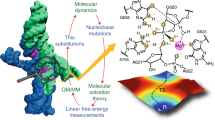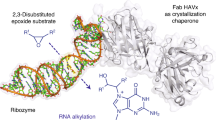Abstract
We present a crystal structure at 2.3-Å resolution of the recently described nucleolytic ribozyme twister. The RNA adopts a previously uncharacterized compact fold based on a double-pseudoknot structure, with the active site at its center. Eight highly conserved nucleobases stabilize the core of the ribozyme through the formation of one Watson-Crick and three noncanonical base pairs, and the highly conserved adenine 3′ of the scissile phosphate is bound in the major groove of an adjacent pseudoknot. A strongly conserved guanine nucleobase directs its Watson-Crick edge toward the scissile phosphate in the crystal structure, and mechanistic evidence supports a role for this guanine as either a general base or acid in a concerted, general acid-base–catalyzed cleavage reaction.
This is a preview of subscription content, access via your institution
Access options
Subscribe to this journal
Receive 12 print issues and online access
$259.00 per year
only $21.58 per issue
Buy this article
- Purchase on Springer Link
- Instant access to full article PDF
Prices may be subject to local taxes which are calculated during checkout




Similar content being viewed by others
Accession codes
References
Nissen, P., Hansen, J., Ban, N., Moore, P.B. & Steitz, T.A. The structural basis of ribosome activity in peptide bond synthesis. Science 289, 920–930 (2000).
Fica, S.M. et al. RNA catalyses nuclear pre-mRNA splicing. Nature 503, 229–234 (2013).
Lilley, D.M.J. & Eckstein, F. in Ribozymes and RNA Catalysis (eds. Lilley, D.M.J. & Eckstein, F.) 1–318 (Royal Society of Chemistry, Cambridge, 2008).
Lilley, D.M.J. & Sutherland, J. in The Chemical Origins of Life and its Early Evolution (eds. Lilley, D.M. & Sutherland, J.) 2851–2986 (Royal Society Publishing, London, 2011).
Buzayan, J.M., Gerlach, W.L. & Bruening, G. Non-enzymatic cleavage and ligation of RNAs complementary to a plant virus satellite RNA. Nature 323, 349–353 (1986).
Forster, A.C. & Symons, R.H. Self-cleavage of plus and minus RNAs of a virusoid and a structural model for the active sites. Cell 49, 211–220 (1987).
Haseloff, J. & Gerlach, W.L. Simple RNA enzymes with new and highly specific endoribonuclease activities. Nature 334, 585–591 (1988).
Winkler, W.C., Nahvi, A., Roth, A., Collins, J.A. & Breaker, R.R. Control of gene expression by a natural metabolite-responsive ribozyme. Nature 428, 281–286 (2004).
Webb, C.H., Riccitelli, N.J., Ruminski, D.J. & Luptak, A. Widespread occurrence of self-cleaving ribozymes. Science 326, 953 (2009).
de la Peña, M. & Garcia-Robles, I. Intronic hammerhead ribozymes are ultraconserved in the human genome. EMBO Rep. 11, 711–716 (2010).
Seehafer, C., Kalweit, A., Steger, G., Graf, S. & Hammann, C. From alpaca to zebrafish: hammerhead ribozymes wherever you look. RNA 17, 21–26 (2011).
Roth, A. et al. A widespread self-cleaving ribozyme class is revealed by bioinformatics. Nat. Chem. Biol. 10, 56–60 (2014).
Wilson, T.J. & Lilley, D.M.J. The evolution of ribozyme chemistry. Science 323, 1436–1438 (2009).
Han, J. & Burke, J.M. Model for general acid-base catalysis by the hammerhead ribozyme: pH-activity relationships of G8 and G12 variants at the putative active site. Biochemistry 44, 7864–7870 (2005).
Martick, M. & Scott, W.G. Tertiary contacts distant from the active site prime a ribozyme for catalysis. Cell 126, 309–320 (2006).
Klein, D.J., Been, M.D. & Ferré-D'Amaré, A.R. Essential role of an active-site guanine in glmS ribozyme catalysis. J. Am. Chem. Soc. 129, 14858–14859 (2007).
Wilson, T.J., McLeod, A.C. & Lilley, D.M.J. A guanine nucleobase important for catalysis by the VS ribozyme. EMBO J. 26, 2489–2500 (2007).
Cochrane, J.C., Lipchock, S.V., Smith, K.D. & Strobel, S.A. Structural and chemical basis for glucosamine 6-phosphate binding and activation of the glmS ribozyme. Biochemistry 48, 3239–3246 (2009).
Kath-Schorr, S. et al. General acid-base catalysis mediated by nucleobases in the hairpin ribozyme. J. Am. Chem. Soc. 134, 16717–16724 (2012).
Lafontaine, D.A., Wilson, T.J., Norman, D.G. & Lilley, D.M.J. The A730 loop is an important component of the active site of the VS ribozyme. J. Mol. Biol. 312, 663–674 (2001).
Rupert, P.B., Massey, A.P., Sigurdsson, S.T. & Ferré-D'Amaré, A.R. Transition state stabilization by a catalytic RNA. Science 298, 1421–1424 (2002).
Wilson, T.J. et al. Nucleobase-mediated general acid-base catalysis in the Varkud satellite ribozyme. Proc. Natl. Acad. Sci. USA 107, 11751–11756 (2010).
Wilson, T.J. & Lilley, D.M.J. Do the hairpin and VS ribozymes share a common catalytic mechanism based on general acid-base catalysis? A critical assessment of available experimental data. RNA 17, 213–221 (2011).
Nakano, S., Chadalavada, D.M. & Bevilacqua, P.C. General acid-base catalysis in the mechanism of a hepatitis delta virus ribozyme. Science 287, 1493–1497 (2000).
Ke, A., Zhou, K., Ding, F., Cate, J.H. & Doudna, J.A. A conformational switch controls hepatitis delta virus ribozyme catalysis. Nature 429, 201–205 (2004).
Das, S.R. & Piccirilli, J.A. General acid catalysis by the hepatitis delta virus ribozyme. Nat. Chem. Biol. 1, 45–52 (2005).
Chen, J.H. et al. A 1.9-Å crystal structure of the HDV ribozyme precleavage suggests both Lewis acid and general acid mechanisms contribute to phosphodiester cleavage. Biochemistry 49, 6508–6518 (2010).
Lee, T.S. et al. Role of Mg2+ in hammerhead ribozyme catalysis from molecular simulation. J. Am. Chem. Soc. 130, 3053–3064 (2008).
Thomas, J.M. & Perrin, D.M. Probing general acid catalysis in the hammerhead ribozyme. J. Am. Chem. Soc. 131, 1135–1143 (2009).
Rupert, P.B. & Ferré-D'Amaré, A.R. Crystal structure of a hairpin ribozyme-inhibitor complex with implications for catalysis. Nature 410, 780–786 (2001).
Cochrane, J.C., Lipchock, S.V. & Strobel, S.A. Structural investigation of the GlmS ribozyme bound to its catalytic cofactor. Chem. Biol. 14, 97–105 (2007).
Klein, D.J. & Ferré-D'Amaré, A.R. Structural basis of glmS ribozyme activation by glucosamine-6-phosphate. Science 313, 1752–1756 (2006).
Bevilacqua, P.C. Mechanistic considerations for general acid-base catalysis by RNA: revisiting the mechanism of the hairpin ribozyme. Biochemistry 42, 2259–2265 (2003).
Ouellet, J., Melcher, S.E., Iqbal, A., Ding, Y. & Lilley, D.M.J. Structure of the three-way helical junction of the hepatitis C virus IRES element. RNA 16, 1597–1609 (2010).
Tan, E. et al. A four-way junction accelerates hairpin ribozyme folding via a discrete intermediate. Proc. Natl. Acad. Sci. USA 100, 9308–9313 (2003).
Pley, H.W., Flaherty, K.M. & McKay, D.B. Three-dimensional structure of a hammerhead ribozyme. Nature 372, 68–74 (1994).
Murray, J.B. et al. The structural basis of hammerhead ribozyme self-cleavage. Cell 92, 665–673 (1998).
Lipfert, J., Ouellet, J., Norman, D.G., Doniach, S. & Lilley, D.M.J. The complete VS ribozyme in solution studied by small-angle X-ray scattering. Structure 16, 1357–1367 (2008).
Ferré-D'Amaré, A.R., Zhou, K. & Doudna, J.A. Crystal structure of a hepatitis delta virus ribozyme. Nature 395, 567–574 (1998).
Emilsson, G.M., Nakamura, S., Roth, A. & Breaker, R.R. Ribozyme speed limits. RNA 9, 907–918 (2003).
Kuzmin, Y.I., Da Costa, C.P., Cottrell, J.W. & Fedor, M.J. Role of an active site adenine in hairpin ribozyme catalysis. J. Mol. Biol. 349, 989–1010 (2005).
Beaucage, S.L. & Caruthers, M.H. Deoxynucleoside phosphoramidites—a new class of key intermediates for deoxypolynucleotide synthesis. Tetrahedr. Lett. 22, 1859–1862 (1981).
Wilson, T.J., Zhao, Z.-Y., Maxwell, K., Kontogiannis, L. & Lilley, D.M.J. Importance of specific nucleotides in the folding of the natural form of the hairpin ribozyme. Biochemistry 40, 2291–2302 (2001).
Hakimelahi, G.H., Proba, Z.A. & Ogilvie, K.K. High yield selective 3′-silylation of ribonucleosides. Tetrahedr. Lett. 22, 5243–5246 (1981).
Perreault, J.-P., Wu, T., Cousineau, B., Ogilvie, K.K. & Cedergren, R. Mixed deoxyribo- and ribooligonucleotides with catalytic activity. Nature 344, 565–567 (1990).
Milligan, J.F., Groebe, D.R., Witherall, G.W. & Uhlenbeck, O.C. Oligoribonucleotide synthesis using T7 RNA polymerase and synthetic DNA templates. Nucleic Acids Res. 15, 8783–8798 (1987).
Leslie, A.G.W. & Powell, H.R. Processing diffraction data with Mosflm. in Evolving Methods for Macromolecular Crystallography 245, 41–51 (2007).
Winn, M.D. et al. Overview of the CCP4 suite and current developments. Acta Crystallogr. D Biol. Crystallogr. 67, 235–242 (2011).
Adams, P.D. et al. PHENIX: a comprehensive Python-based system for macromolecular structure solution. Acta Crystallogr. D Biol. Crystallogr. 66, 213–221 (2010).
McCoy, A.J. et al. Phaser crystallographic software. J. Appl. Crystallogr. 40, 658–674 (2007).
Emsley, P., Lohkamp, B., Scott, W.G. & Cowtan, K. Features and development of Coot. Acta Crystallogr. D Biol. Crystallogr. 66, 486–501 (2010).
Murshudov, G.N. et al. REFMAC5 for the refinement of macromolecular crystal structures. Acta Crystallogr. D Biol. Crystallogr. 67, 355–367 (2011).
Acknowledgements
We are extremely grateful to R. Breaker for early communication of his data on the twister ribozyme and B. Hunter and L. Huang for valuable advice and discussion. The work was funded by Cancer Research UK (program grant A11722).
Author information
Authors and Affiliations
Contributions
Y.L. performed crystallography; T.J.W. performed mechanistic investigations; S.A.M. synthesized RNA; and Y.L., T.J.W. and D.M.J.L. designed the research, analyzed data and wrote the manuscript.
Corresponding author
Ethics declarations
Competing interests
The authors declare no competing financial interests.
Supplementary information
Supplementary Text and Figures
Supplementary Results, Supplementary Figures 1–15 and Supplementary Tables 1 and 2. (PDF 8919 kb)
Rights and permissions
About this article
Cite this article
Liu, Y., Wilson, T., McPhee, S. et al. Crystal structure and mechanistic investigation of the twister ribozyme. Nat Chem Biol 10, 739–744 (2014). https://doi.org/10.1038/nchembio.1587
Received:
Accepted:
Published:
Issue Date:
DOI: https://doi.org/10.1038/nchembio.1587
This article is cited by
-
Tree diet: reducing the treewidth to unlock FPT algorithms in RNA bioinformatics
Algorithms for Molecular Biology (2022)
-
Efficient in vitro and in vivo RNA editing via recruitment of endogenous ADARs using circular guide RNAs
Nature Biotechnology (2022)
-
Structure-based insights into self-cleavage by a four-way junctional twister-sister ribozyme
Nature Communications (2017)
-
Metals induce transient folding and activation of the twister ribozyme
Nature Chemical Biology (2017)
-
The synthesis of 15N(7)-Hoogsteen face-labeled adenosine phosphoramidite for solid-phase RNA synthesis
Monatshefte für Chemie - Chemical Monthly (2017)



